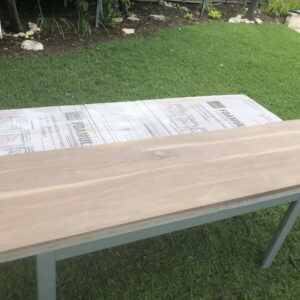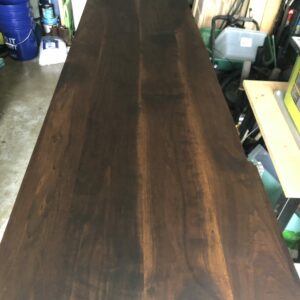Hi there. Ran into some issues with a black walnut counter top I’m finishing, hoping someone here can provide some thoughts/insights on my plan to unwind it.
To provide context, I decided to use Watco DO (black walnut color) and a wet sanding application. I flooded the counter, let it sit for 5-10 mins, wet sanded with 120, let it sit for 30-60 mins, wet sanded with 120 again, let it sit overnight (slurry on), wet it down with the DO again 24 hrs later, sanded with 220, and wiped off all the slurry and finish (just finished).
There are two issues I’m encountering. First, the watco went on much darker than anticipated, so the finish overall is overly dark (lacking the separation I was looking for between sap and heartwood). Yes, likely from not wiping off the slurry the first day which I should have foreseen, but the DO didn’t seem that dark/thick. Second, I’ve got some dark mottling/patching, which I assume is just dried/stubborn DO that didn’t free up with the 220 sanding.
Right now the countertop is fully wiped down (nothing coming off when I wipe with clean rags) in my garage drying. My plan is to let it dry/cure a bit (48-72 hrs) and then sand it with 320 followed by a sanding of 600 (no more DO). My thinking is that the sanding will loosen up/remove the persistent DO and some of the top layer coloring while leaving the pore filler and penetrated stain, resulting in an overall lightening/differentiation (remove some of the top layer of the DO).
I assume I could also give it a light wipe with some thinner or mineral spirits to take off some of the DO before it cures, but I dont like the potential unevenness of that fix.
Thoughts? Other ideas? Appreciate any help.
Thank,
Rick
















Replies
Danish oil is not a film finish. Wet sanding it into the wood is fine, but you can't leave the slurry on top. Once you have applied a coat and before it starts to set up, you must wipe it all off of the surface and let it cure (according to instructions on the can) before applying any more.
For what to do now: I would start with a well sharpened scraper to shave off all of the dried slurry. Then sand it with the grain using 180-220 grit until you are almost into the wood. Then apply one or two more coats following the directions. Doing this you may or may not lighten the color. You may want to switch to an non-colored Watco (Natural). If it is still too dark, you may have to sand it back even more and start over.
I'm pretty sure you're supposed to apply, let it sit for a bit, wipe it off, let it dry and repeat. I think you missed the wipe off step. You might hafta scrape/sand it all off and redo. You could also start with plain Watco Walnut and add black transtint till your scrap test piece looks the way you want it. Keep notes on your new finish recipe.
Transtint doesn't work with oil without a special additive.
But it does have varnish in it. Maybe the varnish component is starting to set when you do your wet sand, and it gums up. I'm no expert, but I've only done wipe on wipe off with DO.
Hey, thanks for the replies. Yeah, I didn't "miss" a step... everything I did was intentional. My mistake was that the guidance I was working with regarding leaving the slurry on was likely for regular, non-tinted DO (to let it set and darken a little). I should have realized that leaving the tinted DO on overnight would darken it substantially, but that's hindsight.
I won't be sanding to bare wood... that's unnecessary IMHO and a step too far. The finish isn't that uneven or horrible, it's just a little dark with some persistent DO in spots. So, I'm moving forward with my plan to wipe it down with some spirits (cleaning it up and taking off the looser/uncured finish) and then graduated sanding with 320/600. I'm going to play it by ear on the sanding... if the 320 doesn't have the desired impact I'll go down to 220, then climb back up to 320/600.
I'm confident that will somewhat address my concerns, but we'll see what happens... If anyone has any additional thoughts or experience with tinted DO please chime in.
Thanks,
Rt
No difference between tinted and natural. Both are rub on, soak in, wipe off, cure, and repeat. The object is to get as much oil as you can INTO the wood. Leave nothing on the surface.
320-600 are too fine and provide no benefit. 220 is fine enough during the finishing process. When the finish is cured, if you want to polish, then you can go to 600-1000. I'm not sure you will get much benefit even then with DO.
The slurry is not the problem. I've left sanding slurry from DO on dozens of projects overnight or even a couple of days. Just apply more DO the next day and wipe it all up and buff out with burlap or 0000 steel wool. Frankly, this is the beauty of using Danish oil.
Your mistake was using DO with stain in it. You won't be able to get rid of its effects unless you plane, scrape, or sand enough material to get below where the oil has penetrated. Since you sanded it in, expect to have to remove a 32nd or so to get to fresh wood, maybe more. If less, count yourself lucky. That, or live with it.
If you decide to live with it, just reapply the DO (natural, not with stain), let it sit five minutes or so then wipe it up -- old sanding slurry and all. Let it cure and reassess any dry spots a few days later. You might need to go another few applications. DO is a very long-oil varnish. You can get surface build, but it takes a lot of applications. Paste wax over completely dry DO completes the finish.
Always test your complete finishing routine on project scrap before working on the live project. Use fresh materials. I wouldn't use DO that had been opened and sitting around for more than a few months. Always shake the can thoroughly before using. The varnish resins sink to the bottom.
Yeah, it's funny, I watched a lot of videos and read a lot of articles about using dark walnut watco specifically, and I liked all their results. I think the difference is that even when they sanded it in they wiped it off immediately/quickly.... they didn't give the stain a chance to really sink in and concentrate itself. And then the guidance I read about leaving the slurry on (from pretty solid sources, to your comment) was all "regular DO" (non-tinted), which would be much lighter no matter how long you left it on..
Oh well, live and learn. I don't actually think I'll need to sand it down that much... while I sanded the DO in, I'm good with some of the penetrated color remaining in the wood (especially the pores). I just want to reduce the overall saturation to increase some of the contrast and allow more of the walnut's grains to contrast/show through. Once I get to that point I'll have to decide if I give it a final coat of regular DO or just water poly it (plan has always been to seal it at the end with water poly since it's a counter).
One question: would you let the it cure a little bit before you started sanding or would you just jump right into it? I rubbed it down with some spirits this morning, was planning to let it sit another 24 hrs and then sand it a bit. Interested in any thoughts.
Thanks,
Rt
I do one 'regular' application -- put it on, let it sit 30 minutes or so then wipe it off. The next day I do a sanded in application -- I put the oil on and start sanding. All this works better when its warm it seems to me. I almost always leave the sanded in slurry on the project overnight, then do it again, leave it on overnight again, then do a last cleanup application of plain oil -- I let it sit for 15 minutes or so then wipe everything down removing all the slurry. Let that cure for a couple of days, buff with burlap or 0000 steel wool, then wax.
Always make sure you clean up the rags and sandpaper and get them out of your shop. Dump them in a bucket of water then dispose of them.
Don't worry about rubbing it down with mineral spirits -- DO is almost all mineral spirits in the first place. Just use the product exactly as instructed on the can, or sand in a couple of applications as I've outlined. You don't have to sand. It does help tone down the sapwood in walnut, even if you use the DO without stain. It doesn't tone it down so much that you ruin the look if you've designed with the sapwood in mind -- it can look good, it's not always something to be gotten rid of. Too much on a board can affect that boards stability though- can make it move.
In theory, water based poly would work OK over very well cured DO. However, IMO, I wouldn't do it. Just to be safe, use an oil based poly. I think mixing oil products and water products is asking for problems.
The general rule of thumb in painting (which is similar to but not identical to wood finishing) is water over oil, never oil over water. The simplified reason is that water breathes while oil doesn't, so oil on water will end up failing terribly. I did some research and water poly over DO is apparently completely fine and actually recommended as one way to protect a DO finished piece.
If someone more knowledgeable knows that to be incorrect please lmk, but it seems pretty solid.
This forum post is now archived. Commenting has been disabled